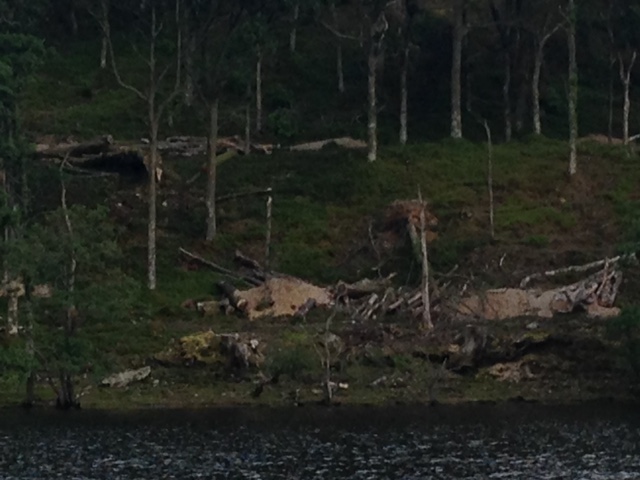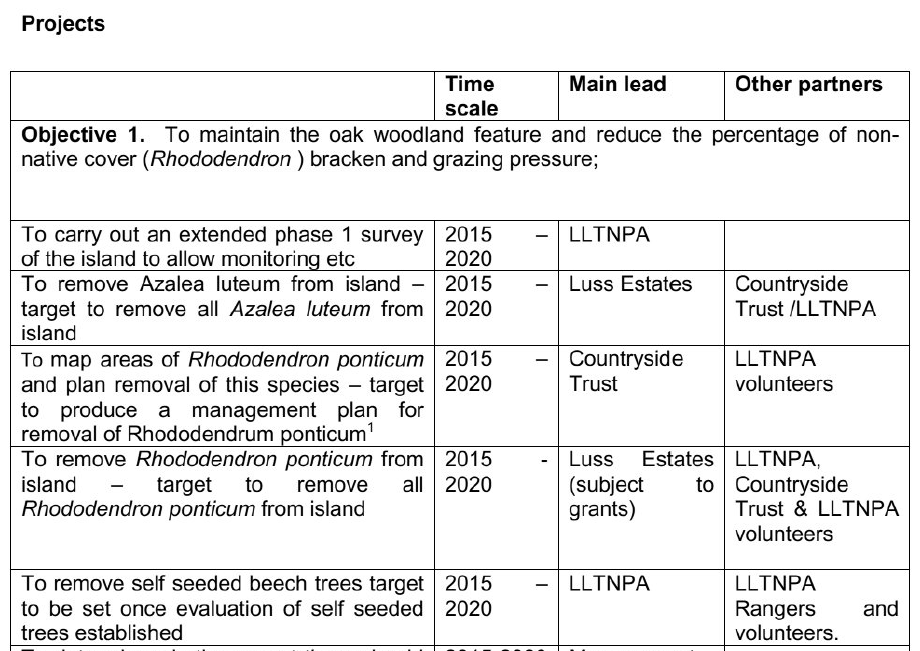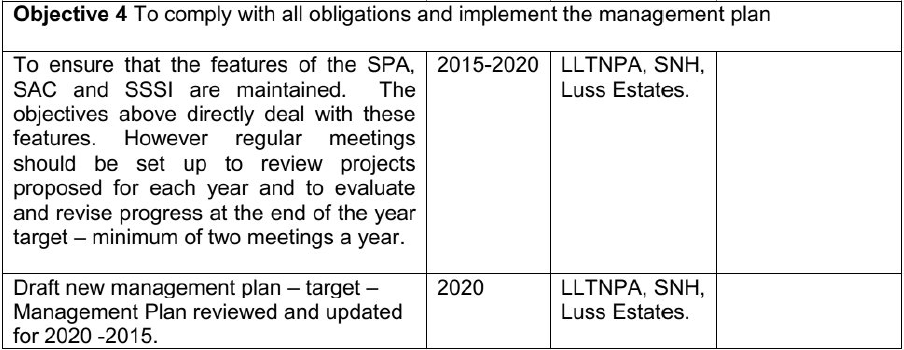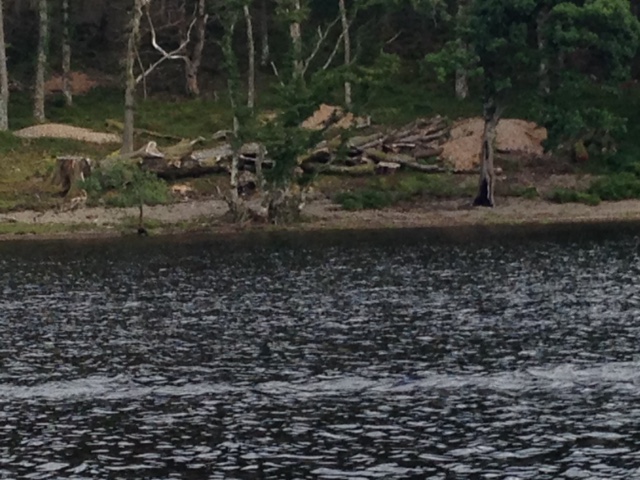
Back in August, I noted from the Loch Lomond & the Trossachs National Park Authority weekly planning list the following planning application from Luss Estates Ref 2018/0166/DET (see here):
Proposal Change of use of former slate quays to allow a) the unloading of felled timber (Storage and Distribution Class 6), b) occasional use for the temporary erection of marquees etc for private functions (Assembly and leisure Class 11) and c) occasional car parking and storage of vehicles, plant and machinery (Storage and Distribution Class 6). Location Camstraddan Slate Quays By Luss Applicant Luss Estates Company
At the time I surmised that the felled timber referred to could be that from the island of Inchtavannach where many beech trees were cut down or poisoned by Scottish Natural Heritage (SNH) (see here). Then, this article in The Herald (Thursday 12 Oct. 2018) appeared.

What’s going on?
In June Luss Estates submitted another Planning Application to renew a previous consent to build on the neighbouring island of Inchconnachan 2018/0011/DET (see here). This again contains a document called Inchconnachan Management Plan 2015-2020 and its worth re-quoting (see here) the extract from the SNH Site Management Statement for the Site of Special Scientific Interest:
“oaks on neighbouring Inchtavannach were planted from Dutch stock approximately 200-300 years ago, and were managed to supply small timber products and tannin for the factory in Balloch”.
The Loch Lomond & Trossachs NPA feature largely in this Management Plan along with SNH and Luss Estates itself.

and

Luss Estates has never denied that they had an agreement with SNH and indeed this was reaffirmed on BBC Radio Scotland on the morning of 16 Oct.’18 where Simon Miller (CEO Luss Estates) was interviewed by Gary Robertson. Mr Miller said the agreement had been to fell the beech trees over a five year period; not all at once. A spokeswoman from SNH was also interviewed but felt constrained by the ongoing legal battle.
The question still remains as to why these mature beech trees were killed at all when the oaks were planted?.
Quite what kind of agreement Luss Estates had entered into with SNH is unclear, and whether it was under the auspices of a Management Plan involving LLTNPA is also unclear. All we do know at present is that SNH, as they do for all Sites of Special Scientific Interest, issued a Site Management Statement (their objectives for the site) and list of Operations requiring consent (see here). While this classifies the beech trees as non-native – now out of date – and needing management, it says nothing about felling them:
“Rhododendron, beech and non-native conifers are present on both islands and are also a problem requiring management. Rhododendron ponticum can spread rapidly so control work must be maintained within a reasonable period of time to eradicate this species from these islands.”
And, ironically, given the poisoning of the trees, they required Luss Estates to seek their consent for:
“6 Application of pesticides, including herbicides (weedkillers).”
What we do know is that whatever the agreement was, the appalling situation we now have on Inchtavannach is a result of it.

Management Plans and Integrated Land Management Plans
Quite how the Inchconnachan Management Plan fits with the Integrated Land Management Plans the LLTNPA is promoting with landowners (see here) is unclear:
Integrated Land Management Plans are our way of working closely with land managers within the context of their individual businesses to develop strategic plans which will identify and progress actions that will progress multiple benefits for both private interests and National Park priorities. Our aim is that these Plans will become the basis of a long-term relationship between each business and the National Park Authority.
By collaborating with these businesses to develop Integrated Land Management Plans, we aim to improve their economic and environmental sustainability in order to support the integrated land use practices that will deliver these Park priorities.
The creation of an integrated land management plan involves working closely with land managers to discuss their current and future business plans. We support land managers to plan and deliver multiple environmental and social benefits alongside economic return, through the creation and delivery of an integrated land management plan.
Conservation Priority 4.1 of our National Park Partnership Plan for 2018-2023 covers integrated land management plans.
We utilise the knowledge of our in-house experts and seek assistance from external partner agencies including:
- SEPA: https://www.sepa.org.uk/
- Scottish Natural Heritage: https://www.nature.scot/
- Forestry Commission Scotland: https://scotland.forestry.gov.uk/
(extracts from NPA website re Land Management Plans)
This raises some interesting questions:
- So how did the disaster on Inchtavannach come about with all the so called experts with their advice?
- On the basis of whose judgement are these people experts at all?
- Do these quangos only consult to write Plans?
- Do they even consult together at all?
- Is this a good use of public funds?
- Who are the winners in schemes like this?
It seems odd to me that a National Park Authority should be involving themselves in the running of private businesses. This is not what they were set up to do. They and other (Government) quangos are writing these Plans with private landowners and then contributing public monies to the landowners to help fund what is in the Plans!! Surely that is grossly unfair to non-landowners?
The LLTNPA Papers for the Board Meeting on 14th June 2018 held in Brig O’Turk contained an update on progress with Integrated Land Management Plans (Agenda Item 12 Appendix 1 :4.1) (bold is mine)
4.1 Integrated Land Management 5. Develop, expand and deliver Land Partnerships which deliver better integrated management of the land and water environment providing multiple benefits for nature and people. Behind Schedule
Working with local land managers develop and complete 3 Integrated Land Management Plans in the Park by March 2019. Work with 3 holdings to develop applications for future Agri-Environment grant funding. Develop proposals for next phase of Strathard Partnership by October 2018.
Annual Operational Plan 2018-19 Notes 2 Currently Land Managers considering this have indicated they are not prepared to enter into new Integrated Land Management Plans whilst we are awaiting the outcome of the OSIC (Office Scottish Information Commissioner) appeal [Ed. note: submitted by parkswatch] that may mean we will need to publically (spelling correction publicly) share the information these plans contain. Uncertainty as to the future of Agri-Environmental & Climate Scheme makes it difficult to get land managers to commit to investigating the opportunities that the funding scheme can provide.
So there appears to be a reluctance on the part of landowners to allow the tax-paying public to know what monies they receive from the public purse! That in itself implies that the reward for joining the scheme is very substantial. It seems it was okay to take public funds so long as the public didn’t know about it and no-one knew just how much?
*It may be worth noting that at the same Board meeting Agenda Item 13. Confidential – 2018/19 Corporate Risk Register (i.e. the public were excluded).
So much for openness and transparency!!
What needs to happen
National parks need to return to the four Aims as set out in their founding Act:
- To conserve and enhance the natural and cultural heritage of the area
- To promote the sustainable use of the natural resources of the area
- To promote understanding and enjoyment (including enjoyment in the form of recreation) of the special qualities of the area by the public
- To promote sustainable social and economic development of the area’s communities.
Nowhere in these aims does it give NPA’s the right to hand out public funds to private businesses, especially when the aims of those businesses are kept secret form the public.
- The LLTNPA needs to make all land management plans it is signed up to public
- LLTNPA and the other quangos need to consult on a new plan for Inchtavannach and the other Loch Lomond islands
- There needs to be more ‘joined up’ thinking within NPA’s and the quango’s they favour.
- There needs to be less use of meaningless jargon and “parkspeak” and more plain “nitty gritty” detail (the LLTNPA Partnership Plan is an example of this … lots of large, pretty pictures but very little substance.)
- LLTNPA management need to be more proactive in monitoring what landowners do post Planning consent